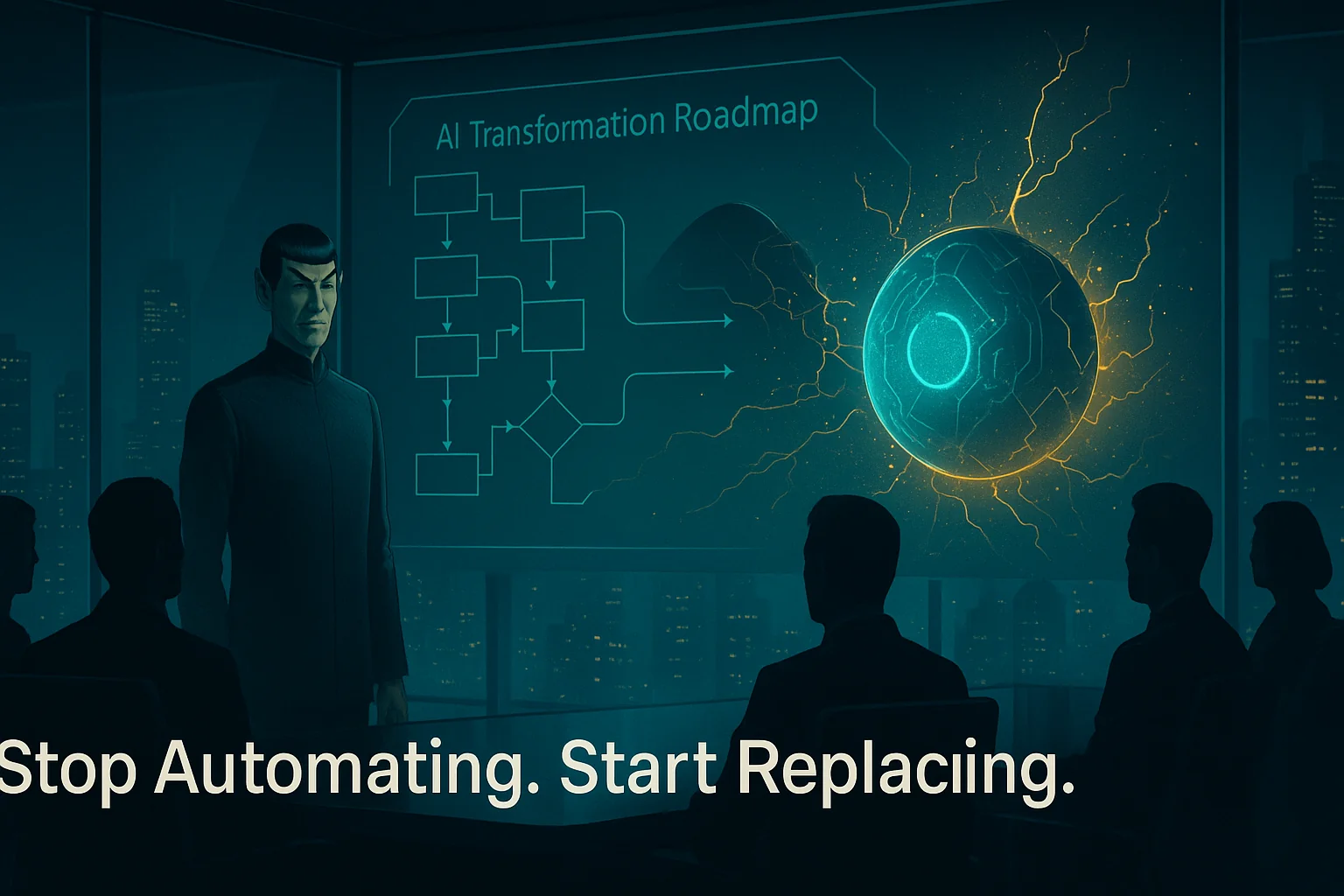
Stop Automating. Start Replacing.
Why Your AI Strategy Is Backwards—And What to Do Instead
📚 Want the complete ebook version?
Imagine Spock walking into your boardroom during an AI strategy session.
He scans the whiteboard. “AI Transformation Roadmap.” Boxes and arrows everywhere. “Phase 1: Automate customer onboarding. Phase 2: AI-assisted reporting. Phase 3: Intelligent document routing.”
One eyebrow rises.
“Fascinating,” he says. “You’ve identified twelve steps in your tender process and propose to accelerate two of them. May I ask: why do these twelve steps exist?”
Silence.
“The logical question is not which cogs to grease. It is whether this machine should exist at all.”
The Gen AI Paradox
Nearly eight in ten companies have deployed generative AI in some form. And nearly eight in ten report no material impact on earnings.
McKinsey calls this the “gen AI paradox.” Widespread deployment. Minimal transformation. The technology works. The strategy doesn’t.
The problem isn’t capability—it’s methodology.
Most organizations approach AI the same way they approached every previous technology wave: find existing processes, identify bottlenecks, apply new tool to bottleneck. Rinse and repeat.
This worked for assembly lines. It worked for ERP systems. It even worked for basic RPA.
It does not work for AI.
“You can’t automate your way to transformation. You have to rethink the work itself.”
— Bain & Company, “Unsticking Your AI Transformation”
The companies stuck in the paradox are asking the wrong question. They’re asking which cogs to grease. They should be asking whether this machine should exist at all.
The Automation Trap
A construction company recently sent me their tender process. Fourteen steps. Three different software systems. Two manual handoffs where someone copies data from one spreadsheet to another.
Their question: “Which 2-3 steps can we speed up with AI?”
Wrong question.
The right question: “In a world where AI can read documents, understand context, and coordinate workflows—why do we have fourteen steps?”
They weren’t asking me to help them win more tenders. They were asking me to help them lose tenders faster.
Automation greases the cogs. It makes existing processes run smoother, faster, cheaper. It preserves the fundamental architecture of how work gets done.
AI-first design replaces the machine. It asks whether the process itself should exist in its current form—or any form.
The mathematics are stark. McKinsey’s research on agentic AI shows three levels of integration—and a 10x performance gap between the first and the third:
| Approach | What It Means | Typical Gains |
|---|---|---|
| Assistive | AI helps with individual tasks within existing workflow | 5-10% |
| Layered | AI handles specific steps, but process architecture unchanged | 20-40% |
| Reimagined | Entire process designed around AI autonomy | 60-90% |
That’s not 10% better. That’s 10x better. The difference between greasing cogs and replacing machines.
The Needs of the One
In Star Trek II, Spock sacrifices himself with the words: “The needs of the many outweigh the needs of the few.”
This is industrial logic. Standardize. Optimize for the average. Accept that some customers won’t fit the mold. Build rigid systems and tell people to conform.
AI inverts this entirely.
The needs of the one can now be met at scale.
Industrial processes were designed for an “average customer” who doesn’t actually exist. Every edge case was friction. Every exception was cost. So we built systems that optimized for the statistical middle and shrugged at everyone else.
AI doesn’t work this way. AI recomputes.
Instead of one rigid process designed for an imaginary average, you can now have an intelligent core that treats every customer as unique. The path recalculates each time. The system adapts to context. It shows respect by not assuming “you’re just like the last 500.”
“AI analyzes vast amounts of customer data, identifies patterns, predicts preferences, and automates content delivery to create hyper-relevant interactions at scale.”
— Salesforce AI Personalization Guide
This isn’t a feature. It’s the fundamental capability that makes automation-thinking obsolete.
When recomputing per-customer costs less than maintaining one-size-fits-none, optimizing for “average” becomes the inefficient choice. The Spock logic flips: serving the many now requires serving each one individually.
Training Wheels, Not Sunk Costs
“But we’ve invested millions in our current systems.”
Good. That investment already paid off.
Your legacy CRM taught you how to think about customer data. Your tender management system taught you what information matters when bidding. Your spreadsheets confess exactly how you actually work—not how you think you work, but what you really do when no one’s watching.
This is valuable. Just not in the way you think.
Modern AI can read screenshots. It can infer data models from CSVs. It can understand your process by examining your artifacts—the tools, the data, the habits you’ve accumulated over years.
Your old systems aren’t obstacles. They’re training wheels.
Instead of sending in business analysts to write 80-page requirements documents, AI reads what you already have and treats that as the starting point. The screenshots are UI specifications. The CSVs are data models. The manual workarounds are process documentation.
Then you design an AI-first version: fewer systems, fewer manual handoffs, one intelligent layer that understands the whole workflow instead of a dozen apps that each know one tiny slice.
The legacy IT was the dress rehearsal. AI-first is opening night.
What AI-First Actually Looks Like
Consider a customer service operation:
Traditional Approach
Customer calls. Agent answers. Agent searches knowledge base. Agent types response. Supervisor reviews. Case closes. Ten handoffs, three systems, one hour.
Automation Approach
Same process, but AI drafts the response and auto-searches the knowledge base. 15% faster. Same architecture. Same handoffs. Same human doing the work, just slightly faster.
AI-First Approach
AI monitors patterns across all customer interactions. Detects the issue before the customer even calls. Initiates resolution automatically. Communicates directly with the customer. Escalates only genuine exceptions that require human judgment. Humans become supervisors of outcomes, not doers of tasks.
The results speak for themselves. One major bank transformed their credit memo creation:
“What once required 40 employees and 10 handoffs is now accomplished by four or five employees with no handoffs. Turning a customer insight into a campaign that’s in-market now takes one day, compared with 60 to 100 days previously.”
— McKinsey, “Seizing the agentic AI advantage”
That’s not optimization. That’s replacement. The old machine is gone. A new one—built around intelligence from the start—has taken its place.
The Shepherd Model
This is where most AI consultants get it wrong.
They show up with implementation teams. They scope projects in phases and sprints. They bill hours for building what you asked for—not for questioning whether you should ask for it.
I think of it differently. Spock to your Kirk.
The Vulcan doesn’t command the Enterprise. He raises eyebrows at illogical plans. He provides analysis that changes the captain’s thinking. He walks alongside, not ahead.
This is the shepherd model: advisory, not implementation. The goal isn’t to own the build—it’s to ensure you’re building the right thing.
“You can use your own team, a partner, or us for implementation. My first job is to make sure you’re not automating a process that shouldn’t exist.”
If I ever say “don’t do this,” I’m talking myself out of work. That’s how you know I mean it.
The shepherd walks with you through the transition from automation-thinking to AI-first design. Not preaching from above. Not selling hours to build what you asked for. Just ensuring the question is right before you spend six months answering it.
The Cost of Delay
Every day you spend optimizing legacy processes, you’re setting concrete faster.
Nearly two-thirds of companies spend over $2 million annually just maintaining legacy systems. Banks and insurance companies spend up to 75% of their IT budgets preserving what exists—leaving almost nothing for what’s next.
Organizations dependent on legacy systems take 2-3x longer to implement changes compared to those with modern stacks. And a Ponemon Institute study found that unplanned downtime costs organizations an average of $9,000 per minute—with legacy system failures accounting for 40% of major outages.
But here’s the real cost: while you’re greasing cogs, competitors are replacing machines.
They’re building AI-first operations that outlearn, outadapt, and outserve. They’re serving the needs of the one at scale while you’re still optimizing for an average customer who doesn’t exist.
The question isn’t whether to change. It’s whether to change now—when you have options—or later, when you don’t.
The Right Question
Next time someone asks “which steps can we automate with AI?”—channel your inner Vulcan.
Raise one eyebrow.
Ask: “Why do these steps exist?”
Then ask: “In a world where AI can understand context, coordinate workflows, and adapt in real-time—should this process exist at all?”
The automation question assumes the machine is sacred. The AI-first question assumes nothing is.
Your legacy IT isn’t a prison. It’s a launchpad. The investment already paid off—it taught you how to work. Now use it as input to design something better.
Stop automating your past.
Start designing a future you actually want to work in.
We don’t automate your past. We help you design a future worth automating.
Discover more from Leverage AI for your business
Subscribe to get the latest posts sent to your email.
You may also like...
Previous Post
The Team of One: Why AI Enables Individuals to Outpace Organizations
